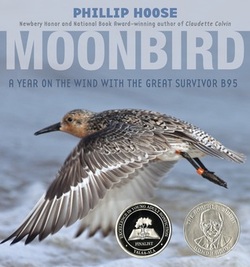About the Book:B95 can feel it: a stirring in his bones and feathers. It’s time. Today is the day he will once again cast himself into the air, spiral upward into the clouds, and bank into the wind.
He wears a black band on his lower right leg and an orange flag on his upper left, bearing the laser inscription B95. Scientists call him the Moonbird because, in the course of his astoundingly long lifetime, this gritty, four-ounce marathoner has flown the distance to the moon—and halfway back!
B95 is a robin-sized shorebird, a red knot of the subspecies rufa. Each February he joins a flock that lifts off from Tierra del Fuego, headed for breeding grounds in the Canadian Arctic, nine thousand miles away. Late in the summer, he begins the return journey.
B95 can fly for days without eating or sleeping, but eventually he must descend to refuel and rest. However, recent changes at ancient refueling stations along his migratory circuit—changes caused mostly by human activity—have reduced the food available and made it harder for the birds to reach. And so, since 1995, when B95 was first captured and banded, the worldwide rufa population has collapsed by nearly 80 percent. Most perish somewhere along the great hemispheric circuit, but the Moonbird wings on. He has been seen as recently as November 2011, which makes him nearly twenty years old. Shaking their heads, scientists ask themselves: How can this one bird make it year after year when so many others fall?
National Book Award–winning author Phillip Hoose takes us around the hemisphere with the world’s most celebrated shorebird, showing the obstacles rufa red knots face, introducing a worldwide team of scientists and conservationists trying to save them, and offering insights about what we can do to help shorebirds before it’s too late. Through prose, research, and images, Hoose explores the tragedy of extinction through the triumph of a single bird.
My Two Cents: This is a well-written account of a really amazing bird, complete with helpful maps, gorgous photos, and profiles of the scientists who are working to help migratory birds. I especially loved the appendix “What You Can Do”, which will help young readers channel the enthusiasm and interest they gain by reading the book into helpful outlets.
Grade Level: 4-8
Additional Resources (most from the “What You Can Do” section of the book):
- Phillip Hoose’s website
- Games, activities, and ways to help at the National Audubon Society’s Just for Kids page
- Check out the Shorebird Sister Schools Program and connect with kids all over the world as you follow the migration of shore birds.
- See how arctic animals migrate at Wandering Wildlife, which tracks actual animals of several species using radio telemetry.
- Learn about the rufa red knot and why it’s in trouble at Parks Canada’s site.
- Find out when International Migratory Bird Day is in your area and what you can do to celebrate.
More to Read:
- A fun Phillip Hoose picture book about being kind to little creatures:Hey, Little Ant
- Another inspiring book by Hoose: It’s Our World, Too! Young People Who Are Making a Difference
- Another great middle grade book where birds are featured: Okay for Now by Gary D. Schmidt
- Another middle grade book where Audubon himself shows up: A Nest for Celeste by Henry Cole
- Another book about animals making, well, an incredible journey: The Incredible Journey by Sheila Burnford
